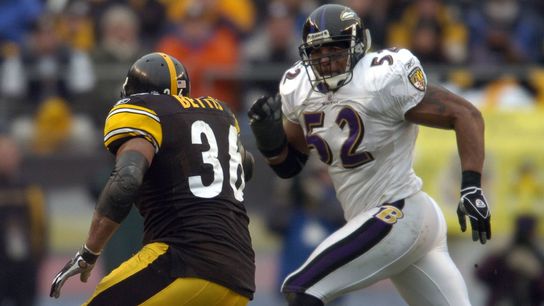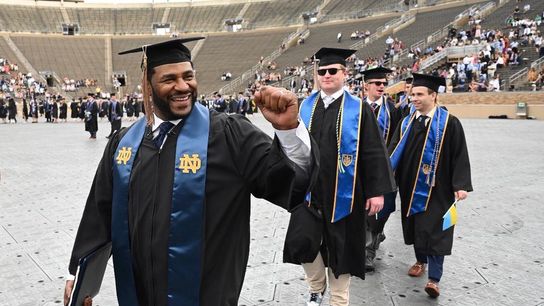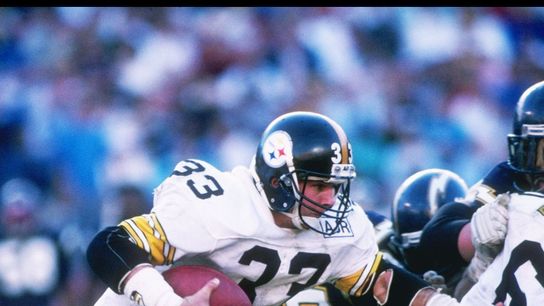The Pittsburgh Steelers have a history of tough, bruising running backs who did not just gain yards, they dished out punishment. It is a tradition that goes back to the very beginning of football in Pittsburgh and fans have embraced bruising power backs for decades. Steelers fans like to see touchdowns, but there is very little that excites a fan of the black and gold more than a five-yard run that features defenders getting bowled over on what should have been a loss.

Baltimore Sun
Steelers' Jerome Bettis meets Ravens' Ray Lewis.
Two of the best power backs in Steelers' history are Merril Hoge and Jerome Bettis for very different reasons. Bettis is the Hall of Fame back that ended a storybook career in Detroit, delivering "one for the thumb" for Steelers fans everywhere. Few players in NFL history are as beloved by a fan base as Bettis is in Pittsburgh. Hoge gave nearly everything he had on a football field, including his life, and maximized limited talent to deliver Chuck Noll’s final playoff victory in 1989.
Hoge and Bettis announced on Thursday that they will be donating their brains to the National Brain Bank at the University of Pittsburgh, posthumously. The University of Pittsburgh is at the forefront of studying traumatic brain injuries like CTE, which seems to affect football players disproportionately.
“Hopefully my donation will help the next generation and the next generation after that,” Bettis said about his decision. “So, we all become more aware and understanding of what the issues are that we are facing.”

(Twitter: @NotreDame)
Jerome Bettis walks down the aisle at his graduation from Notre Dame earlier this year.
Bettis has been an outspoken critic of the NFL for many years on the subject. In 2017, Bettis made news by accusing the NFL of manipulating players and not making them fully aware of the repercussions of multiple head injuries in an Associated Press story that was published in USA Today and various other outlets.
"The problem is we don't necessarily know all the things the league is doing,” Bettis said. "You definitely feel as though you were taken advantage of in a way that you weren't given that information, and you always want to have the choice of knowing, and when that is taken away from you, you feel as though you were taken advantage of."
Hoge conversely has been a skeptic of the link between CTE and football. He was not sold on the link in 2018 when he sat down with John Keilman from the Chicago Tribune to discuss CTE and his book Brainwashed: The Bad Science Behind CTE and the Plot to Destroy Football.

Credit: Steelers YouTube page
Former Steelers running back Merril Hoge has grown into an influential role within the organization as a scout.
“The science community is screaming,” Hoge writes. “We don’t know what causes it, and we don’t know what it causes, but when you see a headline, that is not what you see. That is what drove me to write the book, the truth of the science versus what you see in the headlines.”
The Steelers oversaw Hoge’s care for seven seasons through multiple concussions, but an incident in Chicago nearly cost him his life. Hoge had moved on and was playing with the Chicago Bears in 1994. Hoge suffered a concussion that was so severe, he went into cardiac arrest. The resulting ‘brain fog’ caused doctors to refuse to clear him to play football.

Stephen Dunn / Getty Images
Former Steelers running back Merril Hoge in a game against the Chargers.
Steelers' Merril Hoge Sues Chicago Bears Medical Staff
He retired and took nearly two years to recover. Hoge chalked the incident up to poor treatment and the misdiagnosis of an existing concussion. Hoge sued the Chicago Bears medical staff and won a $1.5 million dollar judgment, though he ultimately only collected $500,000. Hoge is putting his money where his mouth is by acknowledging the importance of continuing scientific study to determine what role football could be playing in brain injuries.
“We’re inviting everybody, not just former players, not just former athletes, but everybody,” Hoge announced. “We need everybody’s assistance in this process, and it is a long process, it’s an arduous process, but the more we have on our team, the more answers we are going to have and the better the team is going to be.”

CBS News KDKA Pittsburgh
Steelers' Jerome Bettis and Merril Hoge agree to donate their brains to the University of Pittsburgh.
The University of Pittsburgh has learned a lot about CTE, but there is no treatment, and it cannot be diagnosed until after a person dies. Hoge and Bettis are an unlikely pairing in this partnership with the program, but the willingness to explore the mysteries of the human brain, and hopefully unlock at the very least a diagnostic (and a therapeutic solution), is cause for hope.
What do you think, Steeler Nation? Are you concerned about the potential impact that head injuries play in contact sports, or are you prepared to take up the challenge laid down by Hoge and Bettis? Please comment below, or on my Twitter @thebubbasq.


